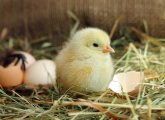Communication adviser Kate Freeman explains how exploring fascinating sounds can help to develop good listening skills.
Most children are born with good hearing; however, all children need to learn how to develop listening skills and focus on sounds.
These are foundation skills for learning to communicate through the spoken word. So, if we want our children to become good communicators, we need to help them with how to develop their listening skills.
You can help children in your setting to develop their listening skills by trying these activities for children from birth to five years.
How to develop babies’ listening skills
Choose different materials from around your setting. This can be anything that will make a good noise when scrunched up, e.g. bubble wrap; tissue paper or wrapping paper.
- Show the materials to the baby and start scrunching and twisting them – talk about the noises they make.
- If the baby is able to hold the materials themselves, let them make the noises while you provide a running commentary about the different noises.
- Comment on what the baby is doing – use repetitive words like ‘noisy’ and ‘gone’. Reinforce the words with your facial expression. So when the baby is making the noise, scrunch up your face and say “noisy!”. This turns the baby’s actions into a game.
How to develop older babies’ listening skills (up to 18 months)
Choose a few different containers, e.g. margarine tubs; bowls; cups, and different things to put in them, e.g. wooden blocks or Duplo; scrunched-up paper; water.
- Take some time to put the items you have chosen into the containers.
- The baby will enjoy filling different containers and pouring the contents from one to another.
- Talk to the baby about listening to the different noises – cup your hand around your ear when you talk about ‘listening’. Talk about how the contents sound, e.g. “The blocks go bang bang”, “Can you hear the water as I pour it in the cup?”
How to develop toddlers’ listening skills (18 months-3 years)
Choose a musical toy or an alarm clock (start with a toy that makes a loud noise and move on to a quieter toy).
- Hide the toy in a fairly obvious place in the room.
- Encourage the child to find the toy by listening to its noise. Say things like, “Listen, can you hear the noise? Where is it?”
- Other children can help by being quiet while an individual child has his or her turn. This also encourages observation and turn-taking skills.
Preschool children (3-5 years)
- Choose a favourite story that the children know well. Tell them that every time you say a particular word you want them to complete an action.
- Make the action appropriate to the word. So in the story We’re Going On A Bear Hunt, ask that they growl like a bear, when you say “bear hunt”. Tell the story normally, but pause each time you say the keyword, so that the children can complete the action.
- Praise them when they have finished and tell them how much you enjoyed the sound/visual effects. If this activity is too difficult, prompt the children by completing the action yourself when the keyword is spoken. If it’s too easy, leave less of a pause so the child has to really concentrate on the words.
More ideas
How many things can children hear if you’re all really quiet?
- Encourage children to be quiet and listen really hard to their environment. It’s likely that there will be background noises that we normally shut out – a dog barking, buses going past, or people talking in other rooms.
- Talk about the sounds you can hear and keep a record of what sounds can be heard where.
- Go for a walk around the building (outside or inside) and listen for noises. Are the noises similar or different to the ones you’ve already heard?
- For older children, talk about the fact we have learnt how to ‘shut out’ noises that we don’t need to listen to. If children find this difficult, you can help by saying their name or having a ‘listen’ signal, e.g. a hand clap.
Support children’s listening throughout the day – ensure that they don’t have lots of different things to listen to at the same time.
Help them by turning off background music to create a quieter environment where children can focus on the sounds that they need to hear.
Get more advice from children’s communication charity Speech and Language UK.
- Subject: Communication
- View page as PDF: Download Now
You may also be interested in...



